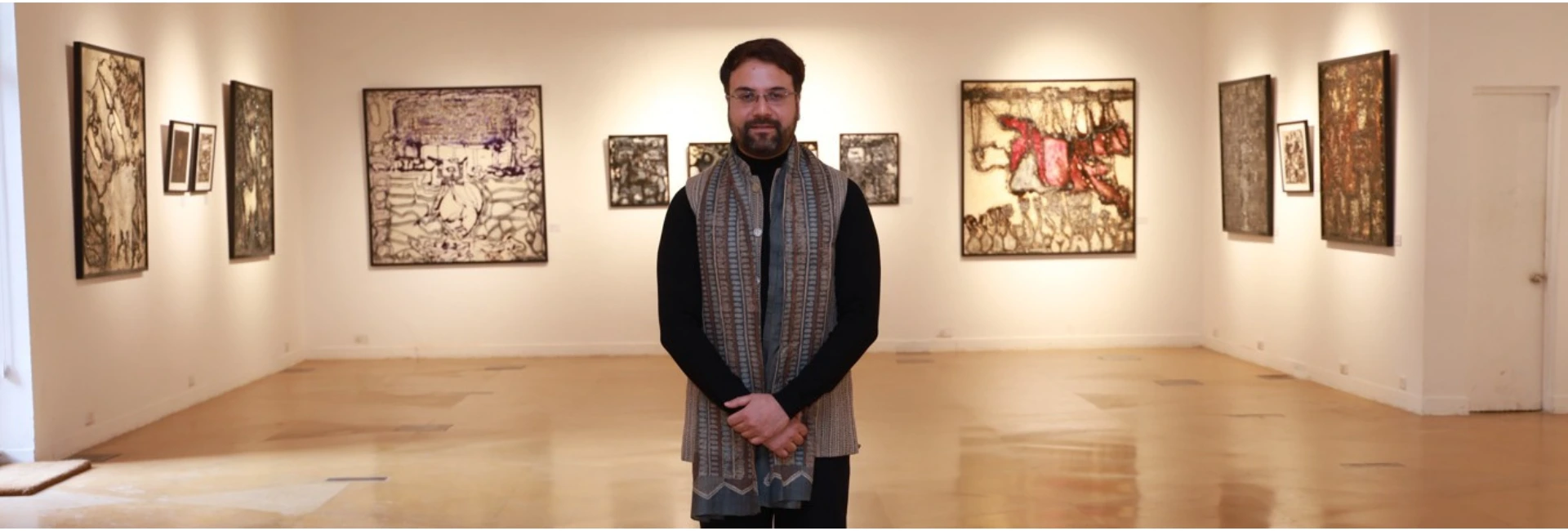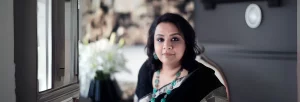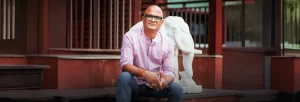(October 8, 2025) It began with a pot of boiling tar on his terrace in Delhi, a chance encounter that would alter the course of Simran KS Lamba’s life. From that molten chaos emerged a mixed media artist who finds poetry in the industrial and spirit in the discarded. His journey, from a terrace experiment to the grand halls in India and abroad, proves that creation often springs not from design but from beautiful accidents.
Lamba transforms what the world throws away — rusted metal, wire mesh, and shards of glass into meditations on endurance and renewal. His unconventional process, which earned him a Government of India patent for innovation in three-dimensional art, turns waste into wonder, making decay shimmer with life.
Now, as he prepares to represent India at the XV Florence Biennale 2025, one of the world’s most prestigious celebrations of contemporary art and sustainability, his vision expands once again onto a global stage. “Art shouldn’t live only in galleries; it should converse with the world,” he tells Global Indian. In his world, even tar speaks, becoming a living, breathing material that holds memory, tension, and transcendence. His art is less about what he creates and more about what he awakens, a reminder that beauty can rise from ruin.
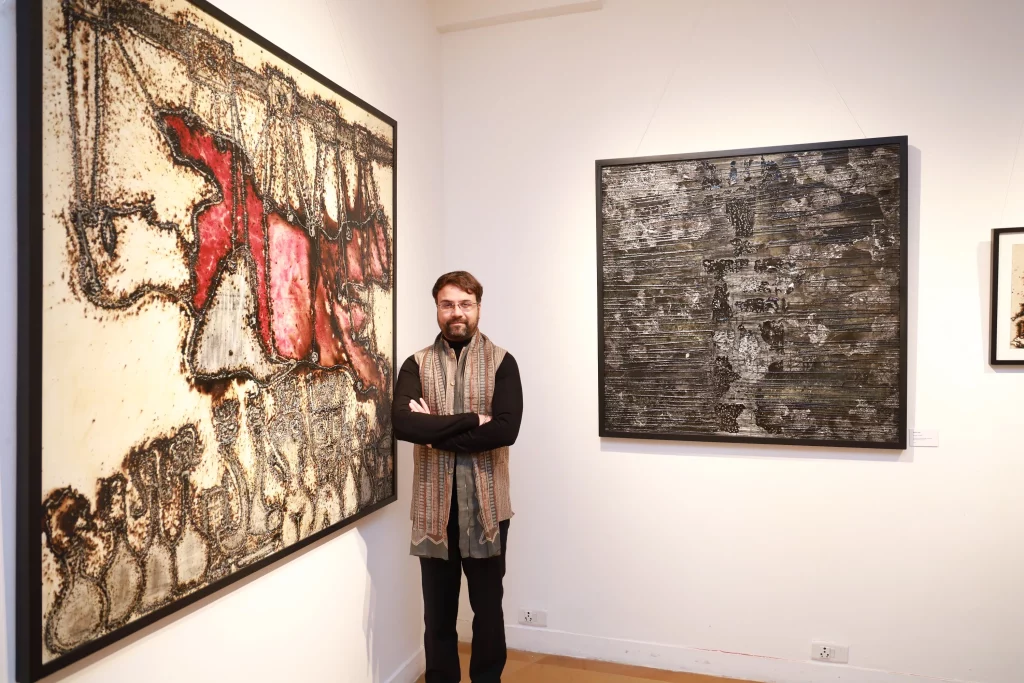
Simran KS Lamba
Roots in revival
The artist spent much of his childhood in boarding schools in Nainital and Shimla, before returning to Kolkata, the city that shaped his early sensibilities. His mother, Mona Lamba, a pioneering veteran fashion designer and revivalist, co-founded the Fashion Design Council of India (FDCI) and led the celebrated label Monapali, founded in the 1980s.
“My mother has been one of the foremost revivalists of her generation,” he says, recalling her role in bringing traditional weaves and hand-stitching techniques into mainstream fashion. “She amalgamated India’s rich textile heritage with contemporary design, and I grew up surrounded by fabric, texture, and form — an environment where questioning aesthetics was encouraged.”
That atmosphere of curiosity and craftsmanship seeded Lamba’s later fascination with unconventional materials and tactile experimentation even if, at the time, he had no inkling he’d one day be an artist.
A chance encounter with Tar
Art, Lamba insists, “happened by chance as opposed to me choosing to be a visual artist.” In 2006, while renovating his home, he happened to come across a pot of boiling coal tar being used to waterproof his terrace. The sight transfixed him. He recalls, “I was extremely enamoured by this pot of boiling hot tar, constantly changing shape. Out of curiosity, I started exploring it, never realizing I was stepping into a lifelong journey.”
What began as fascination soon turned into devotion. He spent years experimenting from learning how to command a difficult, dense, and volatile medium to enduring burns, misfires, and failed compositions. But over time, he developed his own unique techniques: layering, texturing, embedding and an artistic vocabulary that would set him apart.
He states, “Tar is unpredictable, but that’s its beauty. My process was built on accidents, persistence, and the belief that even the harshest material can be poetic.”
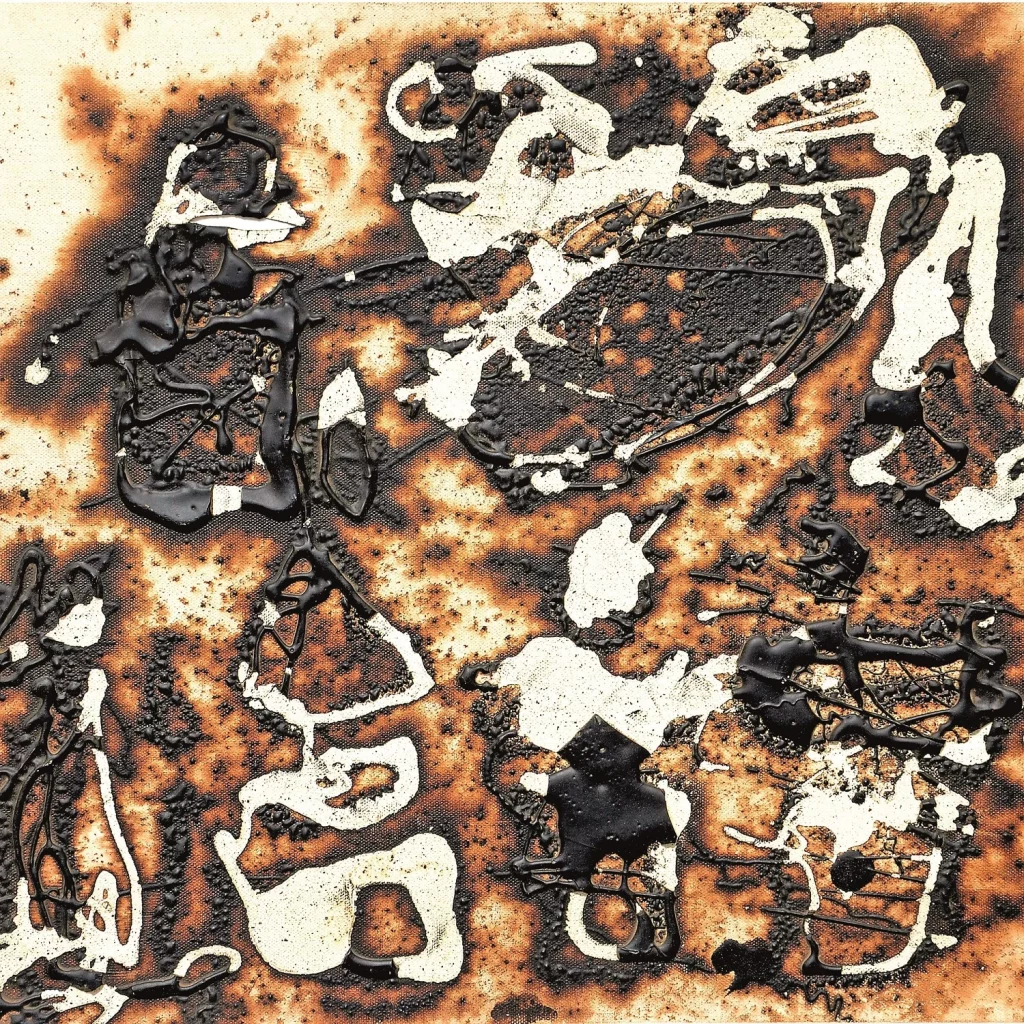
Card Game | Simran KS Lamba
Genesis and early recognition
After four years of exploration, Lamba unveiled his debut solo exhibition, Genesis, in 2010 at the Visual Arts Gallery, India Habitat Centre. The response was electric. Critics and collectors were captivated by the alchemy of his process and the way he turned industrial waste into contemplative forms.
He explains, “That first body of work took me years to produce. It was the culmination of constant experimentation and the validation it received gave me the courage to carry it forward.”
Since then, Lamba’s works have travelled across India and also abroad, featuring in multiple solo and group shows, including the 61st National Exhibition of Art (2020) by Lalit Kala Akademi, where his piece Gandhi and Industry was selected.
A self-taught artist
Lamba proudly identifies as self-taught, a choice that has shaped his risk-taking attitude and originality. “Being self-taught is one of my greatest strengths,” he reflects. “Formal education isn’t for everyone. I was raised to question aesthetics, so I never felt compelled to conform to any school of thought. My art emerges from curiosity, intuition, and the freedom to fail.”
His compositions often defy categorization, part sculpture, part painting, often installation, embracing impermanence, accident, and intuition as collaborators. Over time, he says, his practice has evolved beyond form itself, gravitating toward the metaphysical: “I find myself no longer consciously focusing on what I want to create. Many of my works stem from dreams or vivid imaginings. My subconscious guides me.”
In 2023, the Government of India awarded Lamba a patent for his “unique method of creating three-dimensional artworks” for a journey that began over a decade earlier.
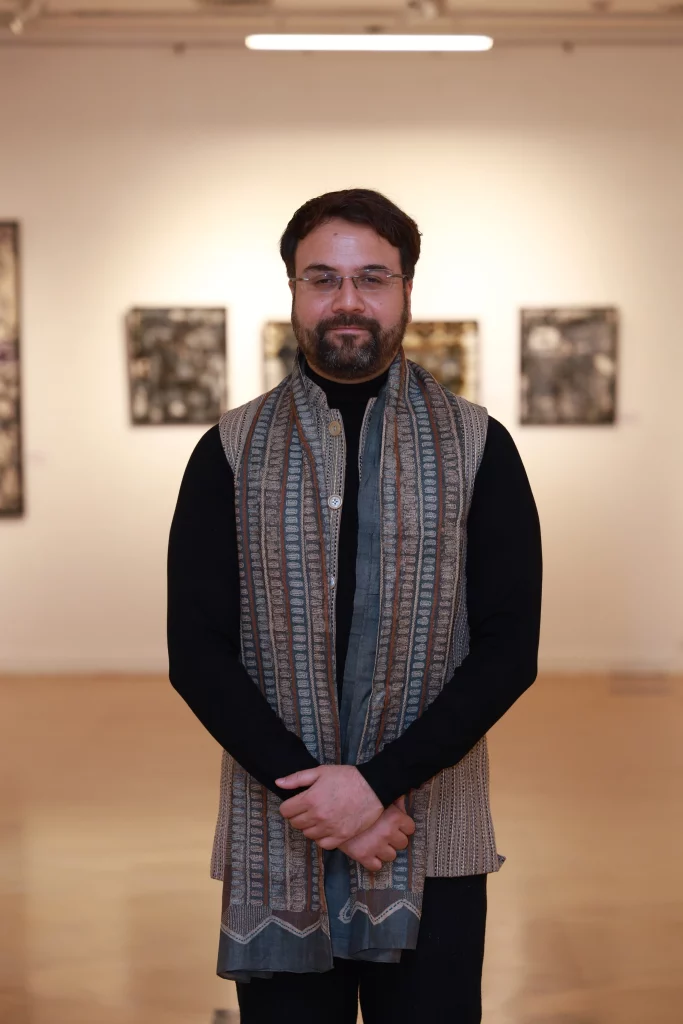
Simran KS Lamba
“During my first show, a viewer told me he’d never seen tar used this way and urged me to apply for a patent,” he recalls. “I did it in 2011. After twelve years of review, the patent was granted.”
The recognition safeguards not just his techniques, but also the integrity of his creative process, after he noticed educational websites offering ‘coal tar art courses’ inspired by his work without credit. “It became necessary to protect my intellectual contribution,” he says, “and ensure that authenticity remains central to my journey.”
Materials as metaphors
Across Lamba’s oeuvre, every material is charged with meaning. Discarded metals, broken glass, and industrial scraps become vessels for environmental reflection and personal memory.
Explaining his process he says, “My use of waste is my way of breathing life into what’s discarded. Copper, for instance, paired with adenium roots, speaks to sustainability, an intersection between industrial mining and nature’s fragility.”
His installations often echo spiritual motifs, a goddess emerging from tar and iron, symbolizing the divine feminine’s omnipresence in every animate and inanimate object.
For Lamba, subject selection is intuitive. Themes emerge from introspection, dreams, and subconscious rumination. “I often find myself meditating on my role on this prism planet,” he muses. “My subconscious distils those reflections into forms and textures. Sometimes I guide the process; sometimes, it guides me.”
This dynamic has birthed acclaimed works like Forest Embers, Gandhi and Industry, and Puppeteer — each oscillating between symbolism and abstraction, grounded in the tactile poetry of their making. There is no template to his work while some paintings take months; others take years.
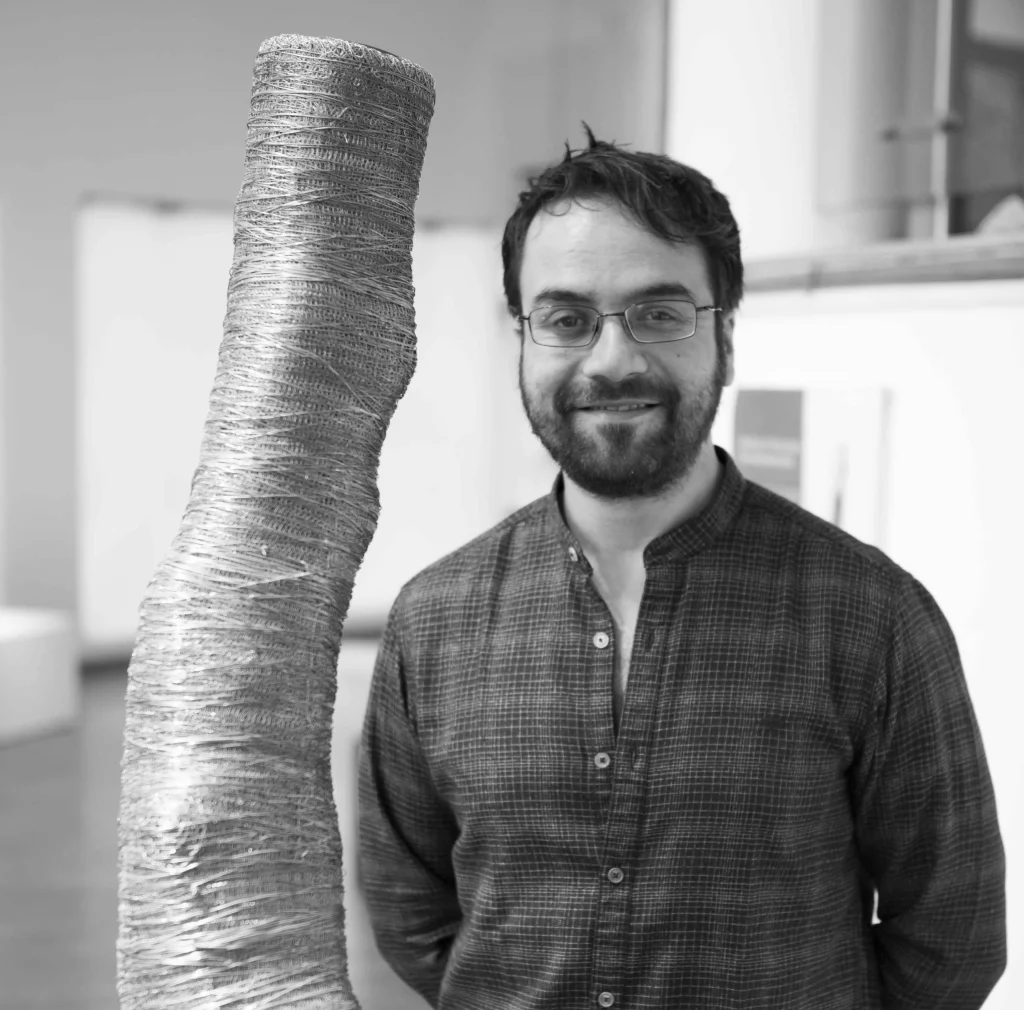
Simran KS Lamba
Inspiration and independence
Despite his literary and theatrical background, Lamba resists the notion of artistic heroes. “I don’t look up to any artist or school of thought,” he says. “My only aim is to express truthfully. My inspiration is my mother — from her, I’ve learned what it means to be a good human being.”
His English literature education introduced him to writers like T.S. Eliot and Thomas Hardy, whose meditations on time and existence resonate with his worldview. And his exposure to the fashion industry nurtured a love for fabric, texture, and form, elements he plans to explore more deeply in future work.
The Florence Biennale 2025: Taking tar global
In 2025, the artist’s work will feature at the XV Florence Biennale, a milestone that extends his artistic dialogue to a global stage.
He expounds, “My selection is a testament that the deeply personal can intersect with the public. It creates a space for dialogue where new perspectives emerge, and artists exchange worldviews.”
He will present three paintings at Florence. Assembly Line Existence, a critique of modern consumerism, depicting a cadaver-like protagonist strung on an assembly line, surrounded by symbolic motifs of excess along with Colour Compression, born from a vivid dream, visualizing the metamorphosis of indigo hues, and Puppeteer, a minimalist white pastel composition, exploring metaphysical control and surrender.
“I hope the exposure sparks discussions about unconventional media and their innate beauty,” he says. “My goal is to show how paintings can be symbiotic, absorbing multiple materials to become something entirely new.”
View this post on Instagram
Expanding boundaries
Looking ahead, Lamba envisions community-driven public art projects, murals, sculptures, and installations sourced from waste sites aimed at engaging rural audiences and celebrating non-conformist narratives. “I want to form collectives with like-minded artists,” he says. Future explorations include tar-emulsion hybrids, exterior garden sculptures, and bicycle-chain installations: each expanding his vocabulary of reinvention. His art continues to dissolve boundaries between waste and wonder, urging us to see that even in what the world discards, there lies the possibility of transcendence.
- Follow Simran KS Lamba on Instagram
Also Read: Lakshmi Mohanbabu: The artist whose work has reached both outer space and the ocean’s deepest depths
